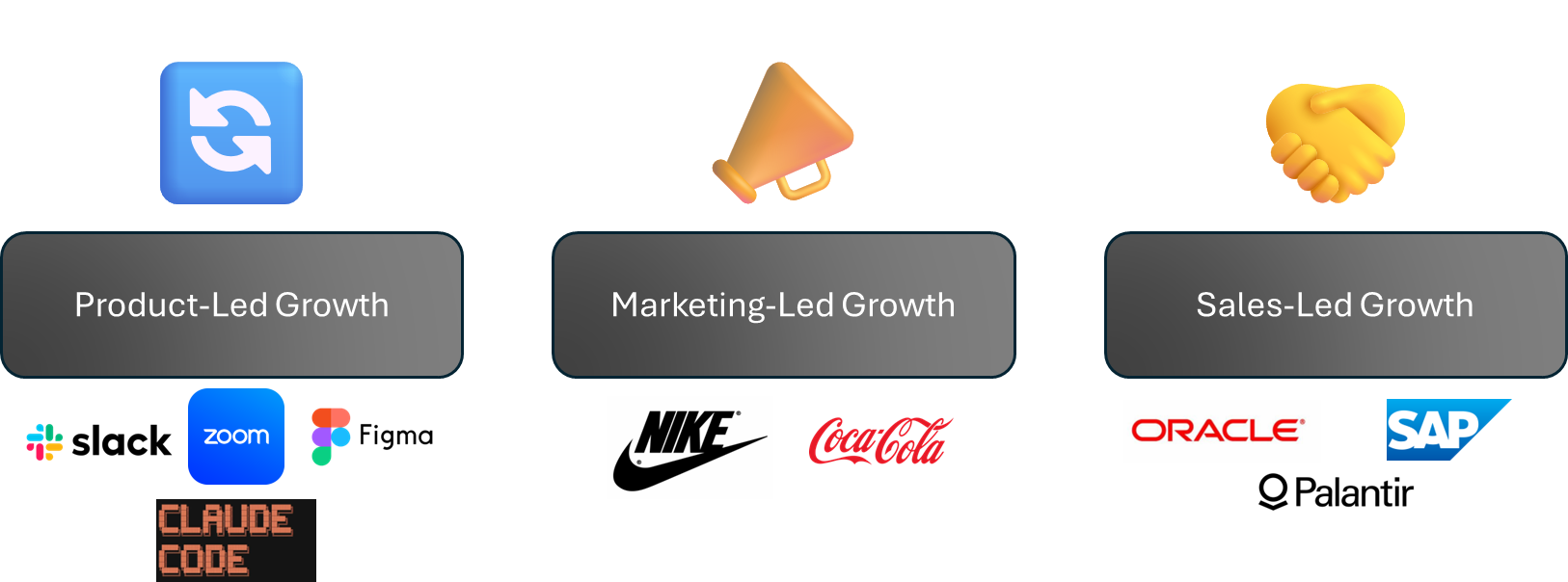Scrum is a framework designed to help teams deal with complexity and deliver value in an empirical way. But what counts as “value” — and how it is inspected and adapted — depends on your context. One often overlooked aspect is your Growth Strategy: the way your organization creates adoption and expands its presence in the market.
In this article, I’ll explore how three common growth strategies — Product-Led, Marketing-Led, and Sales-Led — shape the way Scrum feels in practice. Indeed, while the framework itself is the same, the evidence of value, the stakeholders involved, and the feedback loops often differ.
Three Growth Strategies

Product-Led Growth (PLG)
Growth is driven primarily by the product itself. Users adopt, stick with, and spread it because of its usability, viral features, and immediate value.
- Examples: Claude Code, Slack, Zoom, Notion, Figma
- Typical growth tactics: freemium offers, rapid onboarding, in-product analytics, virality.
Marketing-Led Growth (MLG)
Growth is driven by awareness, campaigns, and branding. Without strong marketing, adoption would stagnate; even if the product is solid.
- Examples: Coca-Cola, Nike
- Typical growth tactics: advertising, brand building, sports endorsement, sponsoring.
Sales-Led Growth (SLG)
Growth is driven through traditional sales activities. Human relationships, procurement processes, and negotiations are central.
- Examples: Oracle, SAP, ServiceNow, Palantir.
- Typical growth tactics: sales activities, demos, RFPs, long-term account management.
In practice, organizations don’t limit themselves to a single Growth Model. Instead, they choose the mix that best fits their context and ambitions. Many products blend elements of all three — though usually with one model taking the lead and the others playing supporting roles.
How Scrum Feels Different in Each Context
Scrum in PLG Contexts
- Teams rely on frequent interactions with actual end-users; as well as on product usage data.
- Sprint Reviews often focus on adoption, retention, engagement metrics, and “Voice of the Customer”.
- Continuous delivery and rapid product experimentations are common here.
Scrum in MLG Contexts
- Teams may deliver marketing campaigns, content, and funnel optimizations. New feature releases may be tied to specific marketing campaigns and events.
- Sprint Reviews often focus on marketing campaign outcomes, A/B test results, or lead conversions.
- Stakeholders often include brand and marketing teams.
Scrum in SLG Contexts
- Teams build enterprise-grade products, usually including non-functional requirements like compliance, integrations, security or performance. Frequent delivery of incremental product improvements is less of a competitive advantage than in the case of PLG.
- Sprint Reviews often focus on giving demos tailored to specific requirements or contracts, on collecting feedback, and on discussing what is coming next in the sales pipeline.
- Stakeholders often include sales and account managers. Scrum supports maintaining transparency and creating alignment between Sales and Development.
Wrap-Up
Scrum is well-suited wherever complexity and uncertainty exist — and all three models have plenty of both. What changes is what we use as evidence of value, and who contributes to the feedback loops.
- In PLG, teams put more emphasis on end-user adoption, product analytics, and “Voice of the Customer”, as evidence of value.
- In MLG, teams put more emphasis on campaign performance and signals from the market, as evidence of value.
- In SLG, teams put more emphasis on customer satisfaction and deal success, as evidence of value.
Scrum doesn’t care whether your growth is product-led, marketing-led, or sales-led. It offers the same foundation: deliver usable Increments, inspect outcomes, adapt. But the data and the interactions that most effectively support the empirical process often change with the growth model.
